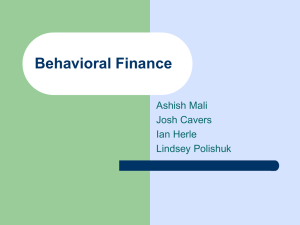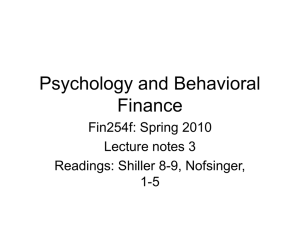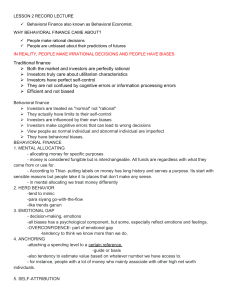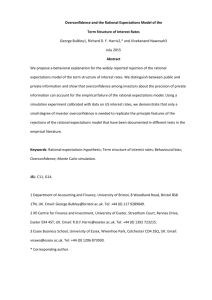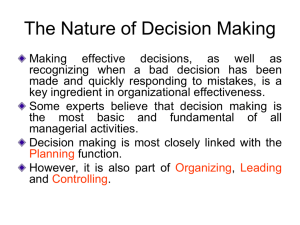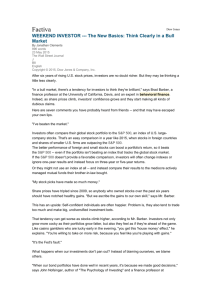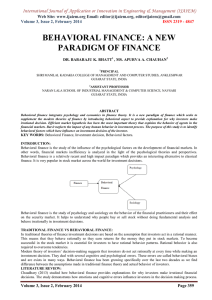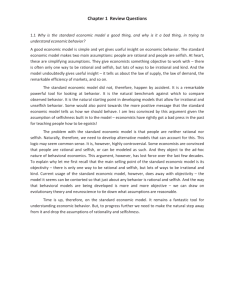PowerPoint on Behavioral_Finance
advertisement
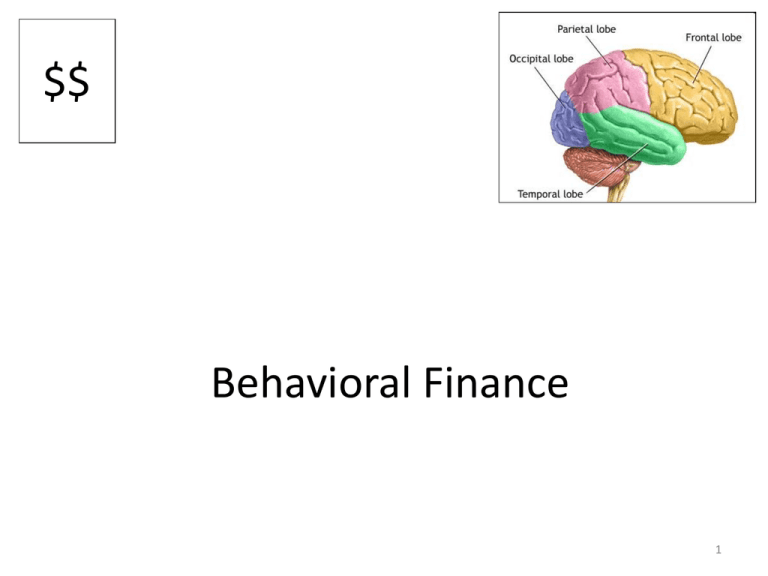
$$ Behavioral Finance 1 Why do financial advisors exist? • Know active stock picking rarely produces winners – Efficient markets tells us information immediately is reflected in prices • If buy baskets/indices and dollar cost average can avoid market timing and active management costs • Just an issue of portfolio mix – % stocks, bonds, etc • Not that hard to learn or do own research – Are people that lazy? Or dumb? – If so, why do so many high-income professionals in finance use advisors? 2 People need help to make decisions • Procrastinate • Have information but don’t act on it • Self-control – cannot resist spending • Sophisticated investors knows his/her limitations – Needs external controls / constraint 3 Traditional vs. Behavioral • Traditional – Rational • Fully informed • Make Choices Consistent with Expected Utility • Behavioral – Some people, some times are not fully rational by the classically rational actor utility model of economics 4 Behavioral finance • Bridge the gap between classical economics and psychology • Individual behavior systematically show psychological patterns – – – – – Overconfidence Anchor too low/high and too slow to adjust Frame losses as worse than relative gains; Valued more highly if owned Chase Trends; Overwhelmed by choice Lack of self-control; Trade at wrong time; Emotional investing • Markets can still be rational when investors are individually irrational. – But that does not mean individuals don’t make major mistakes! 5 Overconfidence • Study of men and women investment accounts – All had negative returns after trading; men 2xs worse than women – B/c males traded too much 6 Heuristics (Cognitive Shortcuts) Strategies decision makers use when faced with decisions, that involve uncertainty: 1. Representativeness – People tend to infer that a single observation is representative of the entire population • Sample Size Neglect in Learning Distribution (6 Tosses vs. 1000 Tosses) • Gambler’s Fallacy - Base Rates are Under-Emphasized Relative to Evidence • Judgment based on similarity. “Patterns in random sequences”. 2. Saliency or Availability: “familiarity breeds investment”. – People tend to over-estimate probabilities of a low frequency event if they have recently heard such an event has occurred 3. Prospect Theory – Investors more risk-adverse in domain of losses than gains 7 Prospect Theory • Proposed by two psychologists: Daniel Kahneman (won Nobel for Economics 2002) and Amos Tversky • Gambles are evaluated relative to a reference point. – Decision maker analyzes “gains” and “losses” differently. – Anchoring • Initial Arbitrary Value and Make Adjustments • Incremental value of a loss is larger than that of a loss. “the hurt of a $1000 loss is more painful than the benefit of a $1000 gain”. 8 Examples of Prospect Theory • Have $300 (“Initial endowment”). • Consider a choice between: – a sure gain of $100 – a 50% chance to gain $200, a 50% chance to gain $0. • Have $500. Consider a choice between: – a sure loss of $100 – a 50% chance to lose $200, a 50% chance to lose $0. • Case 1: 72% chose option 1, 28% chose option 2. Framed as a gain: decision maker is risk averse. • Case 2: 36% chose option 1, 64% chose option 2. Framed as a loss: decision maker is risk seeking. 9 More Systematic Behaviors • Regret Aversion – anticipation of a future regret can influence current decision. • Disposition Effect – Hold losers too long and sell winners too early – Status Quo effect – inertia – Endowment effect – value owned item more • Belief Perseverance • Different search & treatment of contradictory information • Mental Accounting – “Found money” effect • Self-attribution bias – Successes due to talent but failure due to bad luck 10 Fashions and Fads • Herding: may select stocks that other investors select to avoid “falling behind” – Socionomics: People are influenced by each other. – Herding behavior: “safety-in-numbers” • Subjective, unconscious, pre-rational impulses • Rationalize mood-induced moves • ‘Wise’ crowds become foolish – especially as become more uniform • Informational Cascades & Positive Feedback – Example: excessive demand for internet IPOs. • Extremely high opening day returns. – Hindsight Bias • “of course Google was a good buy in 2002” 11 Emotion • Visceral – anger, jealousy, etc • Mild mood or affect – Positive – negative – Anxious – Hopeful • Change self regulation and use of information • Sunny or Rainy Day – Related to market returns? 12 Satisficing • We are boundedly rational – Not out to maximize every decision – “Good enough” not the “best” or optimal • People are ok with doing average – Not out to always beat the average • Works in favor or many investment strategies • When faced with a complex or difficult decisions tend to use two simple heuristics • Keep things as they are (via inertia) OR • Put the decision off (via procrastination) 13 Conflict and the status quo Proliferation of Choice Shoppers in upscale grocery store encounter tasting booths for jams: 6 jams: (40% stopped); 30% bought vs. 24 jams: (60% stopped); 3% bought (Iyenger & Lepper, 2000; B. Schwarz, 2000) 401(k) options: For every 10-option increase, individuals’ participation probability declines by ~ 2% (Iyengar & Jiang, 2005)14 Self Control • Spend / consume too much now • Fail to save for future – Even though you know “future you” wants to “present you” save – “present you” fails to do it • “hyperbolic discounting” rate – not consistent over time/selves • sophisticate: someone who understands his irrationality and builds systems to cope with it – Automatic deposit – Penalty for withdrawal – Save More Tomorrow (use mental accounting to advantage) • Agree this year to save next year • Agree to save portions of future raises – Why do people get $3000 tax refunds? 15 What can we do? • Paying employees to save: – matches don’t work very well • Educating investors: – financial education (alone) doesn’t work – Has some effects but not enough • A complement to other efforts • Change defaults / Re-design processes 16 Make Savings a Default Choice 401(k) participation by tenure at firm Fraction of employees ever participated 100% 80% 60% 40% 20% 0% 0 6 12 18 24 30 36 42 48 Tenure at company (months) Hired before automatic enrollment Hired after automatic enrollment ended Hired during automatic enrollment Madrian and Shea (2001) Choi, Laibson, Madrian, Metrick (2004) 17 Decision Typical Default Automatic Default Participation Join – if you like You’re enrolled Investments Default option is a fixed or money Default option is a balanced fund, market suited to your age Retirement Here’s a lump sum Here’s help balancing the benefits of lump sum with an annuity with guaranteed payments Target Demographic Active decision-makers and planners Reluctant savers and avoiders Source: The Vanguard Group, 2004 18 Hand Holding • Markets down – Fear leads to selling at worst time – Start to question strategies • Buy and hold • Dollar cost indexing • Index funds – Having an external constraint helps • Stick to the plan • Make decisions public – Key role of investment advisor 19 Behavioral Financial Planning • Trusted advisor – Issues maybe very simple; not technical • Financial therapy – People want to tell their story • Self Control and discipline – Keeping promises and reaching goals • Coaching – Self-actuated goals & performance improvement 20
